Jared alerted me to this unique find on Ebay at 5:00 A.M. this morning. Tiny houses and floating homes are a passion of mine and this one a real find.
If you are in the Portland, Oregon area I would run down and check this out right away as I am sure it will go fast. I am in the process of duplicating the Ebay ad as I know it will go away in a few days and I want this available for all to see for a long time. At a Buy Now price of $28,900 it can be yours today.
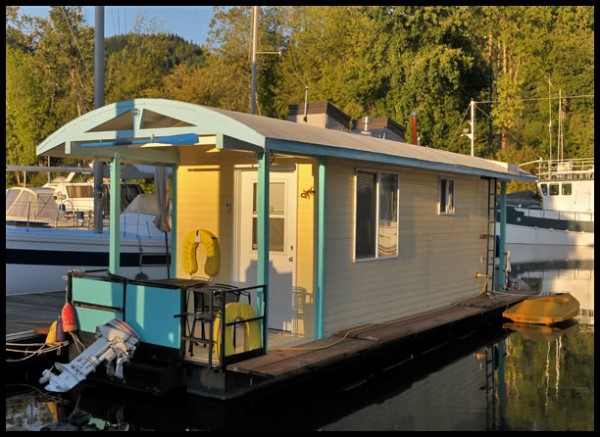

I am also trying to get in touch with the owner to see if plans are available for those who might want to build one themselves. This is a long post so hit the more link below. Here are the details:
You are bidding on a 28-foot long, steel-hulled, river barge boat. If you are considering a small houseboat or floating home for a retreat on the water, this might be a perfect alternative. It could be the perfect bachelor’s pad, artist’s or writer’s studio, weekend or vacation spot, or whatever you would like it to be! It could be a great liveaboard situation for a single person, who is also handy in finishing up some undone work.
This is NOT a fixer. Just not quite finished yet. Pride of ownership shows!
Unofficially named the “Gypsy Ark”, but the name is nowhere printed on the hull or siding, so you could rename it easily. (It is only painted on one horseshoe lifering)
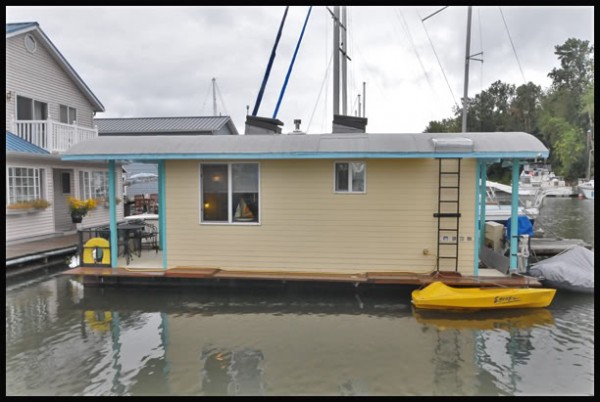
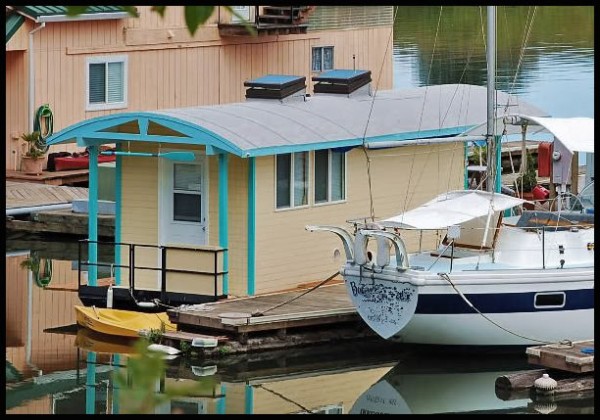
Titled, registered and insured as a boat (“Cruising Houseboat”) in Oregon. Title is clear and registration is current. If boat is sold to an out-of-state (non-Oregon) buyer, title transfer and registration is the sole responsibility of buyer (well, the same is true for the Oregon buyer).


The small hole you see in the wall is the hot-air vent for the A/C. It is located in the galley (kitchen). Outside paint was applied in summer of 2007. The color of the trusses and arches is a combination of turquios and baby-blue (may be hard to see in the photos).
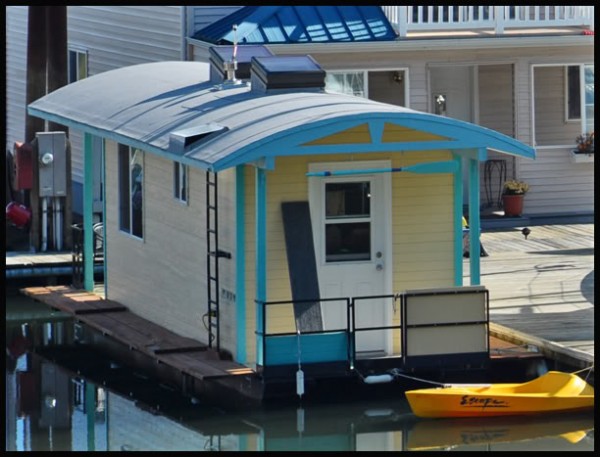
The steel hull was built new in 1983 and had another structure on top of it. The boat was hauled out in 2005 for a reconstruction of the hull and complete replacement of the deck and structure (also called the “pilothouse”). The work on the pilothouse is currently about 80% complete: yet to be finished are some of the “non-structural” parts of the project, such as replacement of the engine steering system, some parts of the electrical systems, and the fresh-water system (plumbing and installation of the water tanks).
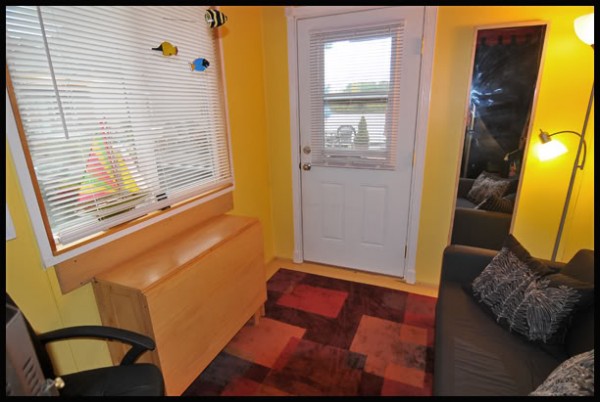
The structure itself is about 19 feet long and 8 feet wide (plus a walkway of 2 feet on each side, making the boat 12 feet wide and 28 feet long; small enough to fit in a regular boat slip). Living room space is about 8 feet x 8 feet. Living room door is 36″ wide. All furniture was bought new within the last 2-3 years.
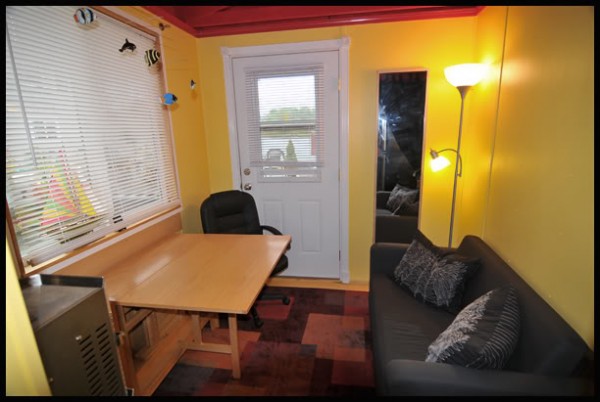
The table and sofa-bed were purchased with a small space in mind. The table is a foldable drop-leaf (double the size than what can be seen in the photo above) and the sofa-bed opens to be a bed. Depending on size and comfort level, it can sleep up to two people.
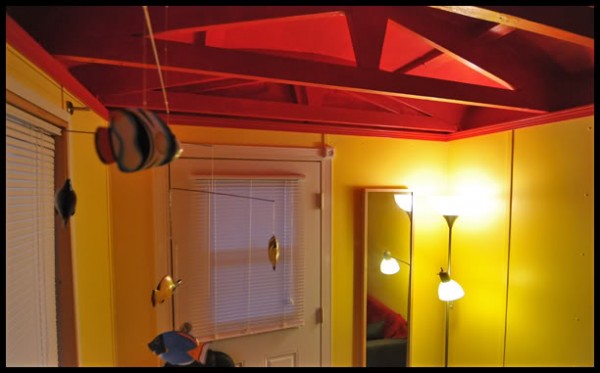
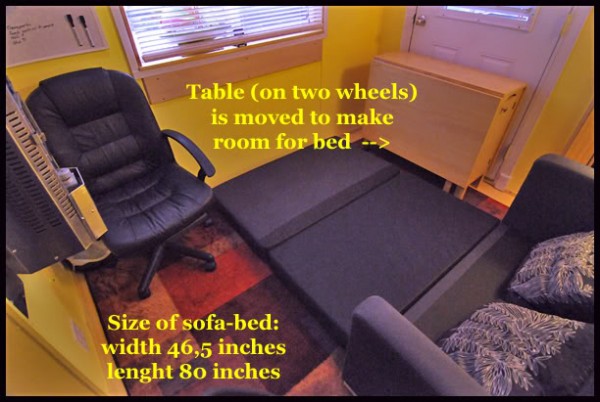
The boat is heated by a diesel heater – fireplace, which we purchased new a couple of years ago. It makes the space very comfortably warm! It burns clean, without soot or odor in the boat. We have been using a temporary fuel tank for the diesel heater. A long-term solution would be a permanently mounted fuel tank.
The floor throughout the houseboat is pressure-treated plywood, painted yellow. Rug in living space, bought new a couple of years ago, is included.
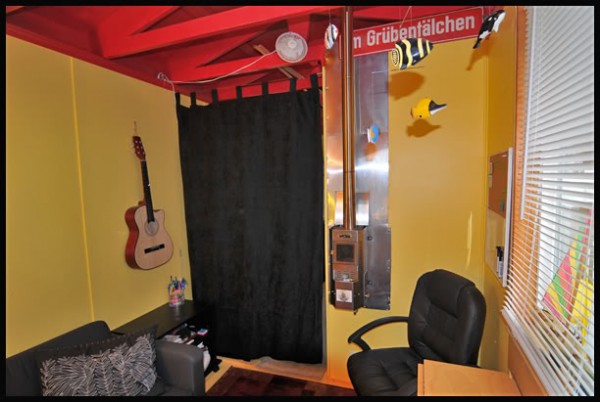


The table can “swallow” up to 4 wooden chairs in its inside, however one broke, so only 3 chairs will come with it. These chairs could be used for the patio, too. Black office chair also comes with the boat.

This is a stained glass window we found at a thrift store. This might be about the only “used” material (besides the original hull) in this boat. The stained glass window is installed in the bathroom wall, facing the galley. If a light would be installed in the bathroom by the new owner, behind it, it could nicely illuminate this stained glass window at night.

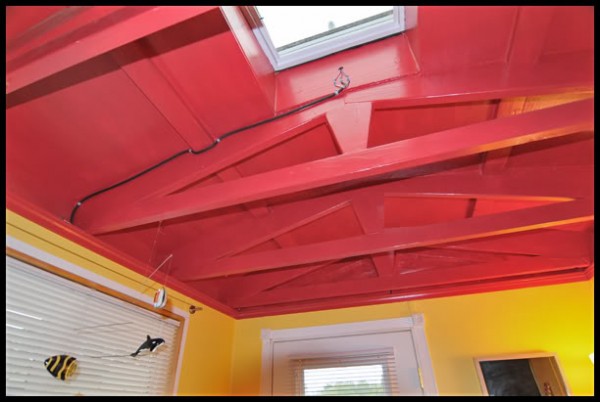
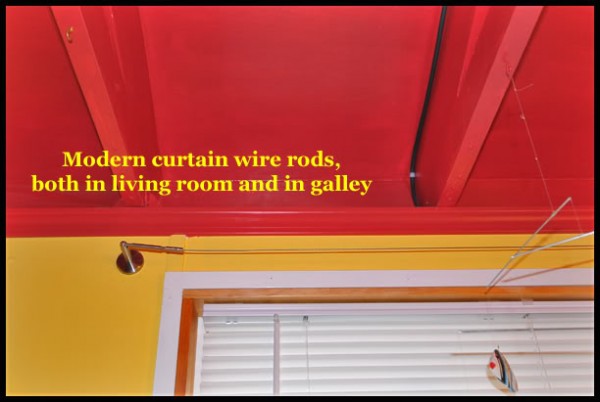
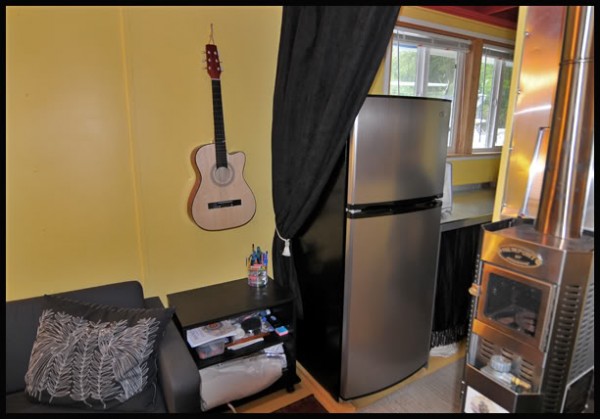
Small shelf next to the sofa is on wheels too: therefore it is very easy to move the furniture around. Sofa is not a full-sized one, so it is not heavy at all. There is also a full-length mirror in the living room.
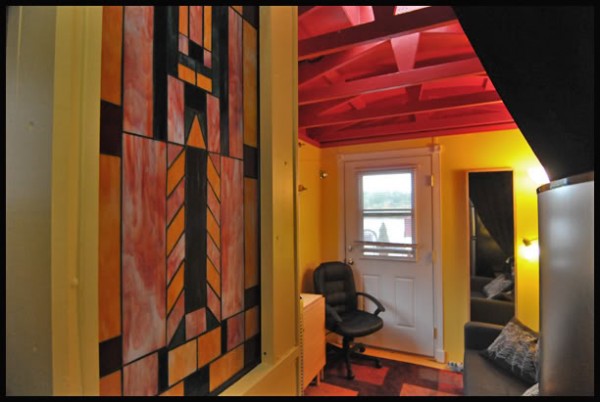
There are some scratch marks on the door in the living room. It would be easy to repaint the metal doors your choice of color.
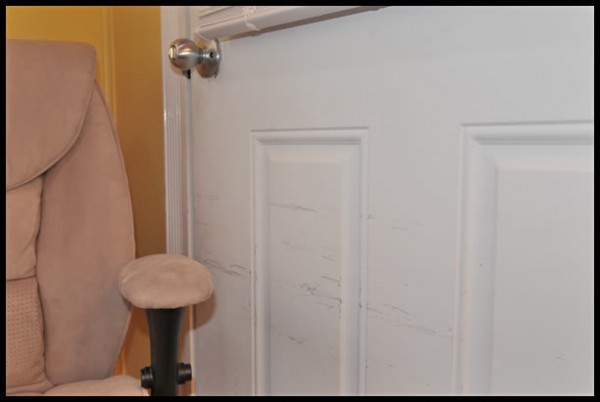
The hull consists of two, approx. 2-ft. square, 28-ft. long, steel pontoons, along the sides of the boat, with a V-shaped full bottom of steel plate welded between the pontoons. Each pontoon is divided into 8 chambers by welded steel bulkheads, for a total of 16 watertight chambers. Each chamber is valved for pressure testing.
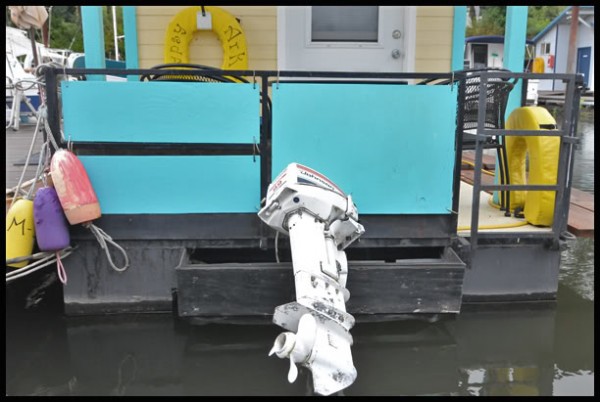
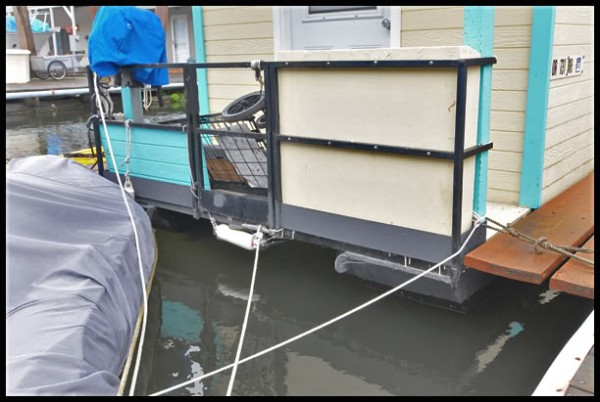
Work done in 2005: Because of some corrosion of the “V” portion of the steel hull, an entirely new, thicker steel plate bottom was welded into place. Some of the hull’s internal structural steel supports were also repaired or replaced at the same time. The entire steel hull was then professionally prepared and painted inside and out with marine-grade, 2-part epoxy paint. The original cabin structure and decking (floor) were completely removed and discarded. The new decking is pressure-treated plywood rated for below-grade/underwater use.
The new pilothouse is framed with galvanized steel studs on 16-inch centers. The walls are insulated with rigid foamboard. The exterior siding is Lousiana-Pacific “SmartSide”. All the windows are Pella “ThermaStar” sliding windows, bought new. Skylights are from Velux. Custom-designed, site-built, wood trusses are used to frame the arched “barrel” roof. The roof is exterior plywood. A CertainTeed “Flintlastic” self-adhering membrane roofing system is installed over the plywood. This is a heavy-duty grade roof material, used on warehouses and other large commercial and industrial buildings. NO LEAKS.
The new deck and pilothouse, including the walls, trusses, and plywood roof, were all built using heavy corrosion-resistant screws (combined with polyurethane glue for all wood joints), instead of nails. This creates superior resistance to the constant flexing motion an on-the-water structure is subjected to. The interior walls are water-resistant panelling made from Luann, a tropical hardwood. The boat’s interior space includes a main cabin, a head (bathroom), a galley (kitchen) and a closet space. The galley is based on IKEA “Udden” stainless steel kitchen counters, including a sink, faucet and four under-counter wire storage shelves.
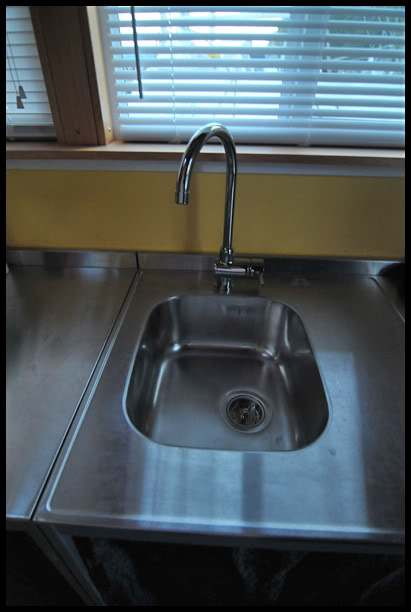
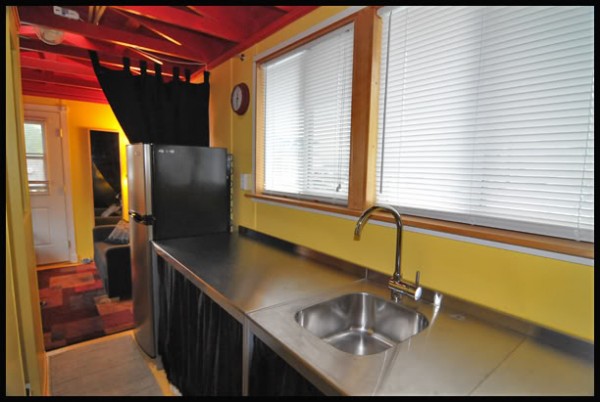
Refrigerator was bought new for the boat about 3 years ago and works perfectly. Freezer compartment is frost-free. Plumbing for freshwater system is not yet installed. No tanks either (the original ones were cracked and patched, so we decided not to re-use them). There is space under the floor to put in the tanks. We call this space the “basement”, however you can only crouch in there all the length throughout the V-shape, if you are of lean to average body build. There are no leaks through the hull, so the bilge stays dry. Also there are no thru-hulls (openings with valves under the waterline) to worry about.
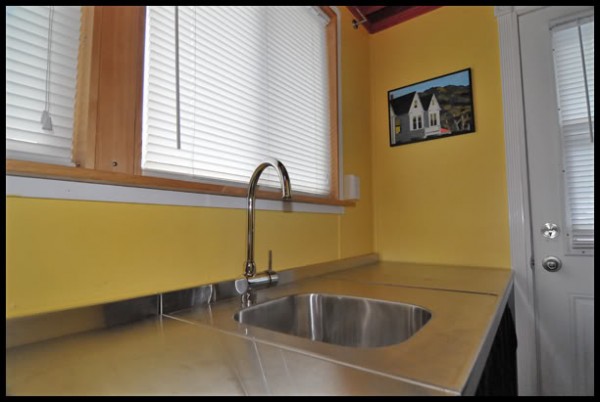
The galley door faces the bow (front) where the helm station is located; the living room door opens onto the stern (back), where the aft deck (patio) is located.
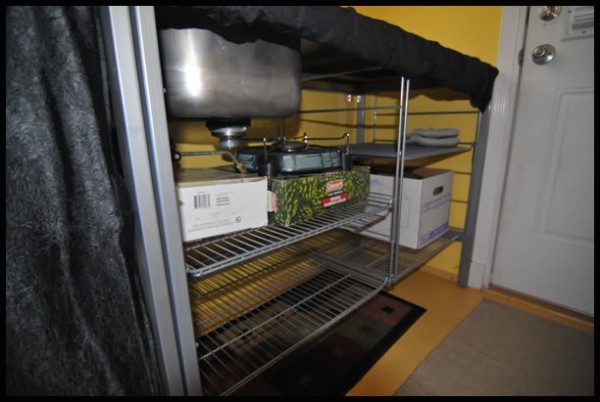
The head has an “Aqua Glass” (fiberglass) one-piece shower stall, 32″ wide, and room for either a portable toilet (porta-potty) or marine toilet to be added.

Also, there is no bathroom door installed yet. We originally planned to just use a curtain, so the air would circulate better.
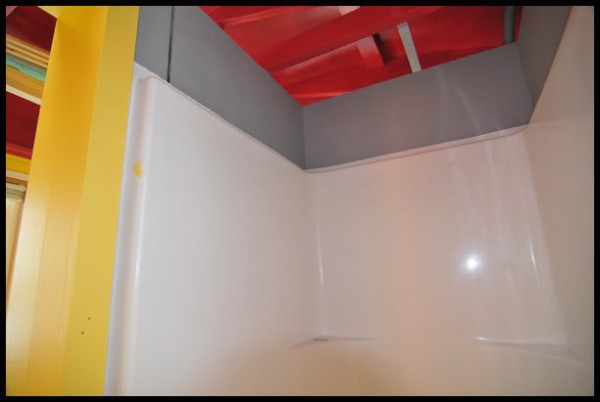
What you can see in the photo below is the backside of the metal heat shield panels that form the wall behind the diesel heater. You can also see an example of how the electric wiring is run in grey plastic conduits. This space would be large enough to accommodate a porta-potty or marine head (the photo makes it appear narrower than it is).


There are two opening, screened Velux skylights in the boat. They work great! One is located above the living room and the other is above the head/bathroom. Also, there’s a new bath vent with fan, heater and light included, still in the box (wiring is installed for it already).
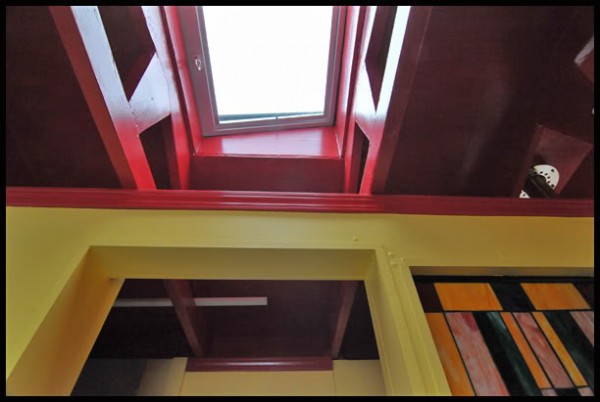
A new water heater is under the galley counter (never used, wiring is in, but plumbing not yet installed). A portable air-conditioning unit is also installed in the boat. This unit also works as a heater. Comes with remote control.

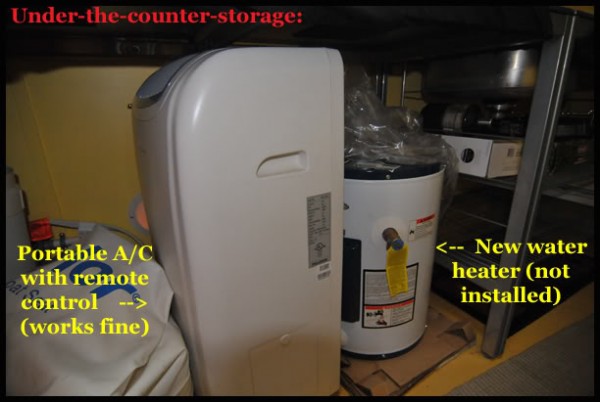
Door in galley (kitchen) leads out to the bow (front) and is 32″ wide. Across from the kitchen counter and the refrigerator is the storage and the head (bathroom).
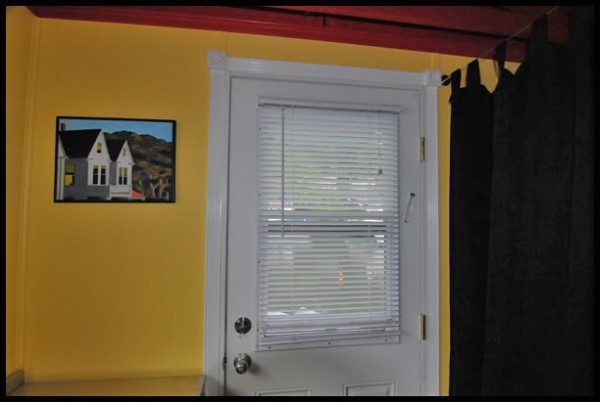
The shore-power (120-volt AC) electrical system includes a Marinco shore power cable and stainless steel inlet, a Charles Isolation Transformer (not yet installed, $540 value), and a Blue Sea circuit breaker panel. All branch circuits for outlets are GFCI protected. The boat’s 12-volt system also uses a Blue Sea circuit breaker panel. All boat navigation lights required per Oregon law and Coast Guard regulations are installed.

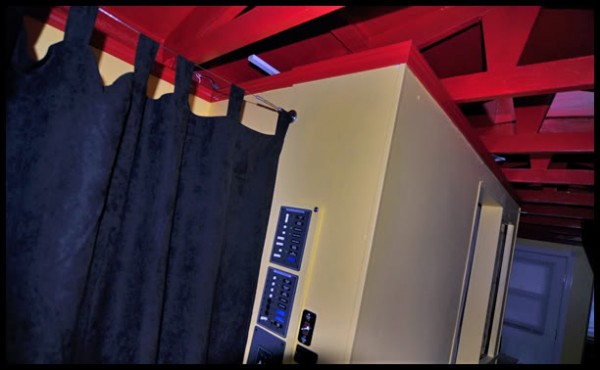

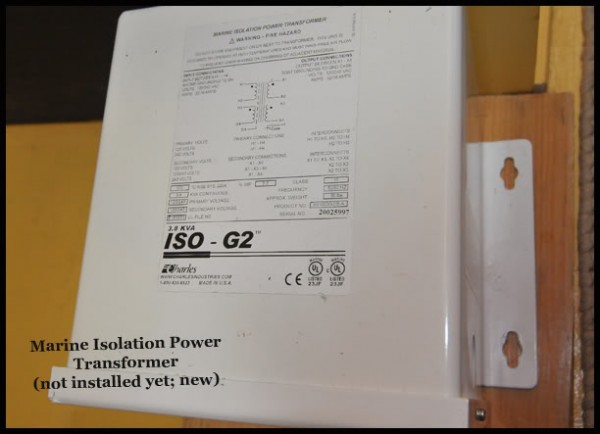
Right now the closet is just an empty space covered with a curtain. There could be shelves installed. Right now there are only some coat pegs there. The helm station (steering and engine controls) is located on the bow (front) of the boat. As part of the reconstruction it was relocated from the original position inside the pilothouse. This outside location gives the boat operator better all-around visibility from the helm station than was possible from inside. It’s even possible to see directly astern (to the rear) from the helm station because the doors both have windows (or just open the doors to see behind the boat). Keep in mind the helm station still needs new wiring and engine control cables installed to be operable. Right now there is a 9.9 HP Johnson outboard engine mounted on the stern. We were told it might run, but we have never bothered to try. It will come with the boat with the assumtion that it doesn’t work and cannot be repaired. If you wanted to move this houseboat under it’s own power, you would probably want a bigger motor anyway.
Aft deck (Patio): It is very comfortable to have two people seated; three would make it a small crowd, and with four occupied chairs we would have to untangle our feet afterwards (patio furniture not included in sale). It is about 8 x 6 feet.
Boat comes with 2 horseshoe life rings and 2 life vests.

Houseboat does NOT include some personal items pictured, like hanging picture, guitar, camping stove/propane burner, and decorations (sign, mobile, etc.). Also NOT included is the patio set (black patio chairs and table).
Boat was used as occasional hang-out and was never lived in full-time.
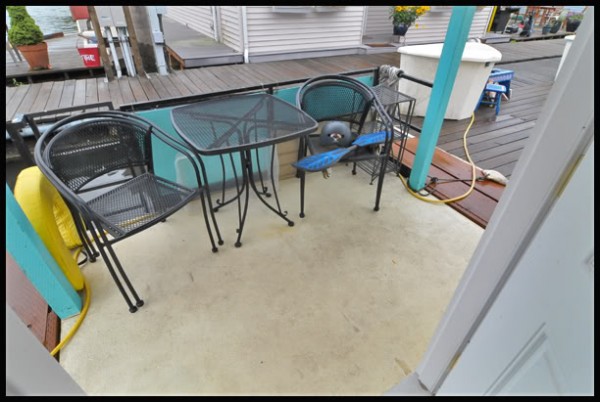
Ceiling above stern:
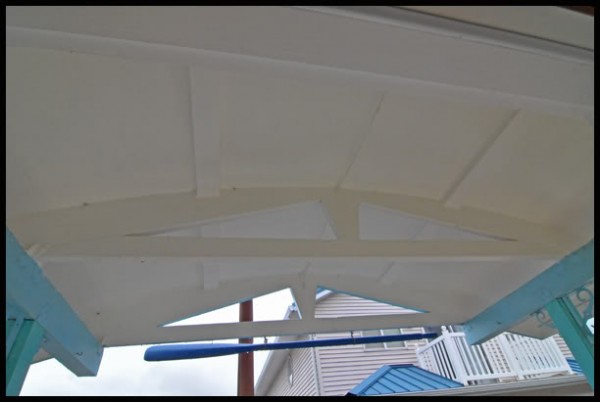
Ceiling above bow:
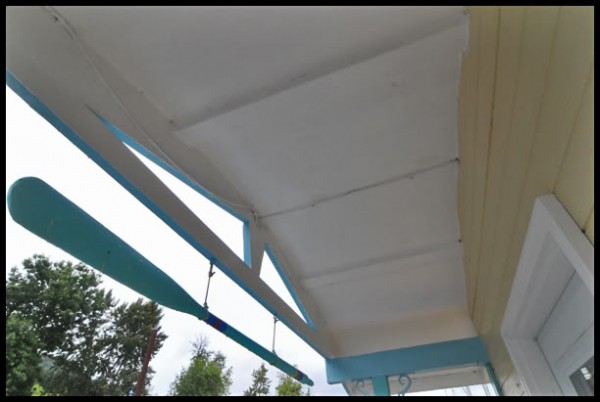
Last winter:

Early September morning on the Multnomah Channel near Portland, Oregon:
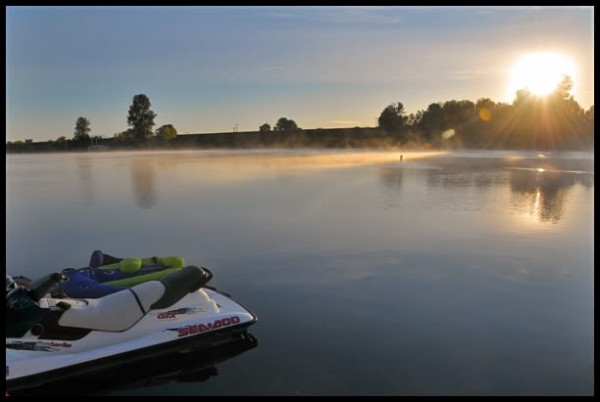
The opposite shore is Sauvie Island, a beautiful agricultural area and wildlife refuge with public sandy beaches that face the mighty Columbia River (gee, it even has a legitimate “clothing-optional” beach. Bridge to reach the island is about a 7 minute drive away.
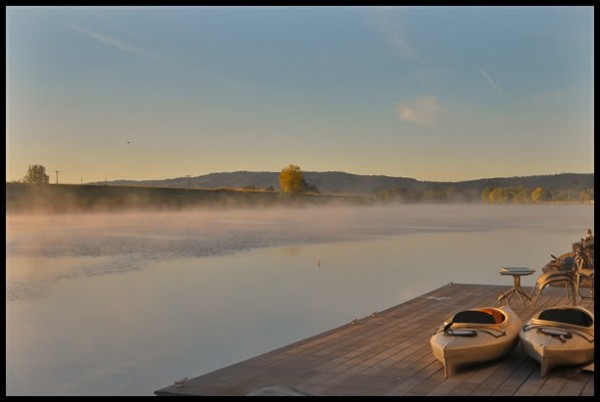
The boat is located in a marina close to Scappoose, Oregon, right now but doesn’t allow new liveaboards. If not used as a full-time liveaboard, it can remain in this marina. Otherwise there are other marinas nearby that do allow liveaboards. You would have to contact them for another slip yourself. Slip is paid through the end of October 2009; after 10/31/2009, the slip fee becomes the responsibility of the new owner.
From Scappoose to downtown Portland it is about a 25-30 minute drive on Hwy 30. This is probably the last highway in the Portland outskirts that is not congested. Traffic such as on Hwy 26 or 217 rarely happens on Hwy 30. From St. Helens, past Scappoose and into Portland there’s also a commuter shuttle bus one could use: the “Columbia County Rider” (has it’s own webpage). The bus stops along in Scappoose several times a day. Another shuttle bus drives from Scappoose all the way to PCC – Rock Creek Campus. If you would live in one of the liveaboard marinas in Scappoose, you could come by even without a car. Either Dial-A-Ride (a scheduled pickup by a small van for $1 within Scappoose), or simply drive with your bike to the bus stop at the highway and let the bus take you and your bike to Portland.
This is a great area to retire. While you get the “rural” feel in Scappoose, Portland is just a short drive away and offers everything you might wish for.
*** FREQUENTLY ASKED QUESTIONS ***
- What is the cost to lift the boat from water for transport: The charge to lift the boat from the water, pressure wash the hull, and place the boat on a trailer for transport is $7.50 per foot of boat length. For the 28-foot houseboat, that would be $210. There would be an additional $25 to $50 charge for the houseboat to be towed from its slip to the boat lift. I cannot give any guarantees in regards to the quoted price (this was just an oral quote given to me and I can’t take the word for it) – you would have to deal with the boatyard and price quotes yourself. The boat lift is located in our marina.
- What are the costs to transport the boat to my location? The cost depends on your location and who hauls your boat. It is wise to get estimates from different boat transport companies. There is at least one such company in our area. A recent oral quote was about $5500 to the Los Angeles area. Again, I cannot give any guarantees as to the accuracy of this quote, as I was just informally asking about the vague “LA area”. We are selling the boat “Where-is”, which means you would have to research and arrange your own boat transport if you want to move it.
- What is the hull’s shape and material? The hull consists of two rectangular pontoons, with a steel hull between them that form a slight “V”. In 2005, when we build the structure on top of this existing hull, we replaced almost the entire area of steel between the pontoons. A metal fabrication shop welded 12-gauge mild steel in between the pontoons (before it was 14-gauge). Some 1-1/2 inch square steel tube was also required to repair/replace the central “spine” that supports the centerline of the hull from front to rear of the boat. I also had them repair 6 of the square steel cross-beams that run under the deck and walkways, and fabricate 8 new ones. The total cost of this work was $4,805. I decided that if the 14-gauge had lasted 22 years (1983 to 2005), the 12-gauge at about 50% thicker would be a wise long-term improvement. I would estimate the pontoons are 2 or 3 times the thickness of the hull bottom, and (including the watertight bulkheads inside the pontoons, and the square tubular steel crossbeams on top of the pontoons), there might be as much as 4 or 5 times the surface area of steel in the pontoons as the new steel welded into the hull.
- What is needed to finish the boat? There are two stages for this: one for the At-the-dock-habitation, which would include some non-complex work on the shore power electrical system, the fresh water plumbing system, and the waste water plumbing system. The second stage is to have the boat capable of being used as an independent, self-sufficient and maneuverable boat away from the dock. This stage would include completing the 12-volt electrical system, installing engine controls, and some other details. Since there are no tanks for freshwater, wastewater, engine fuel tanks or heater fuel tanks, no batteries and no upgraded engine, the weight of the rear of the boat is lighter than it would be with all these things installed. As a result, the stern sits a little higher in the water now (compared to the bow). Port sits a bit lower than starboard because of the A/C, waterheater and refrigerator. We think this also can be straightened out by properly distributing weight by installing the above (tanks and batteries) in the proper locations.
- Could you cruise with it around? At present, a new motor with remote controls would need to be installed, as well as batteries and some of the 12-volt electric system that starts the motor and charges the batteries. The required navigation lights for motoring and for anchoring are already installed and wired to the 12-volt electrical panel, so would work with the addition of the batteries and battery wiring. A portable fuel tank on the rear deck would probably be much simpler to use than a permanently mounted tank under the floor (but that could be done if it was important to have more fuel capacity). If I took it out motoring, I would want it to be a very calm day and would want to have a plan in place to quickly reach a safe location and/or have someone I could call for a tow, if the weather turned for the worse. I have never tried, though, and right now it is not equipped to do this.
- What are the costs of living in a houseboat? This boat fits in a regular boat slip, so what you basically pay is the monthly slip fee. In our marina, the prices are starting at about $130/month, depending on the slip (lenght, location within in marina). For $130, you can use the marina’s bathroom facilities (with shower and laundry) and parking. You can fill up your water tanks for free and you get to use their holding-tank pump-out cart for free (if you have a holding tank, that is; which this boat doesn’t have yet). Electricity is available at each slip, but is metered and paid extra every month. In the summer, the bill for electricity can be almost nothing (well, it’ll be something if you use the A/C) and can be more in winter, depending if you heat your boat with electricity. Next, as a big bonus, you get a whole bunch of friendly new neighbors. Our marina does not allow new liveaboards, but other marinas down the river do. I can imagine that their slip fees are similar (but I don’t know exactly). Liveaboard fees for existing liveaboards in our marina is an additiona $100 besides the regular slip fee. This fee should be similar in other marinas in our area too. So, I estimate, about $250+ a month would sound right, if you live aboard. Depending on marina, as said before. We pay less than $20/month on liability insurance on this boat. Registration to the State is to be paid every couple of years, and is right now about $90 for two years. There are no property taxes to pay and boats are not taxed in Oregon.
- Are there any other regular maintenance issues to be aware of? Yes, on the rare occasion that it snows (it’s happened only once here since we owned for 4 years), the snow might accumulate on the roof to the point where the weight of the snow becomes an issue (as with any other boat or floating structure on the water). Therefore it would be good to keep an eye on this issue and clean off the roof before it gets too heavy.
- Why are you selling this boat? Too many projects, as simple as this. For a while, this houseboat was my main occupation and I and my wife put a lot of money, time and love into making this boat a cozy home-to-be. We put a lot of money, time and love into making this boat a cozy home-to-be. Practically everything from the bottom up (except the hull) is new, and even the hull –the bottom part — was professionally redone and/or replaced in 2005 and we have the receipts to prove it. We didn’t anticipate selling this boat, so we didn’t economize. Yet, I have also another boat (a sailboat) and working on it instead is taking priority. It doesn’t seem right that this houseboat is sitting in the water, unused. We get lots of compliments on how it looks and we want someone else to enjoy it.
This was posted on October 13 and there are 6 days left to bid on the boat on Ebay.
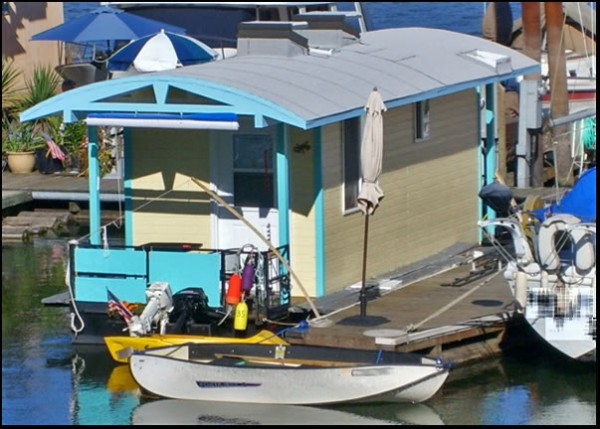
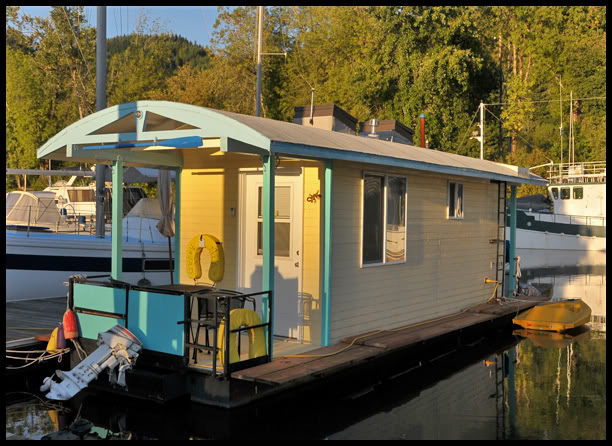
Beautiful! What a great find. If I lived in Portland I would snap it up!
That seems pretty cheap for how nice it is! We looked at renting a houseboat when we lived in Portland and it’s our goal to live on one for a while sometime in our lives… sounds dreamy.
glen-l.com has plans for building houseboats like this one
Why do people continue to use eBay when they are just losing money to them. Try sellbits.com or craigslist. MUCH cheaper and they don’t take percentages. I even think its free.
I like the house boat and it’d be a find addition for me….the expense of moving it to Florida would prohibit it’s purchase, but it’s still very nice !! Wish it were for sale here.
For Adrock: I still use ebay for the exposure…sure I pay a little more, but the audience is much larger.
here are two other websites that houseboat plans: duckworksmagazine.com; simpilictboats.com
call me if you still have this and it is still for sale 541-956-1513
I have sent your email to Conny, the boat was still available as of last week. You can view it here http://www.homeonthewater.blogspot.com/
Great article!
I’ve been looking at small house boats one can build and the one you show here is similair to some barge style Houseboats I’ve seen with designs from the 50’s and 60’s in the 18 to 32 range.
Looks real nice and well kept from the pics.
here’s another small one that i was looking to diy build that is more modern looking and supposedly designed to be eco- friendly.
http://www.jetsongreen.com/2008/10/schwimmhaus-mod.html
According to Google Maps, it’s right here: http://maps.google.com/maps?q=Scappoose,+Oregon&hl=en&ll=45.700272,-122.868483&spn=0.000587,0.000982&sll=37.0625,-95.677068&sspn=43.443045,64.335938&t=h&z=20
We’re can you get a table and chairs like that?